The Telluride has been a great success for Kia, probably because the Telluride is one of the most appealing mid-sized crossover SUVs on the market – on account of its modest price (just $35,900 to start) and its standard V6 for that price.
Which brings us to what amounts to the battery-powered version of the Telluride – the new EV9.
It does not have a V6.
But it is relatively modestly priced. Relative to other battery powered three-row crossover SUVs such as the Rivian R1S and the Tesla Model X.
That appears to be what Kia is counting on to make it a success.
The EV9 is a mid-sized, three row crossover SUV that’s dimensionally and stylistically similar to the Telluride but battery rather than engine-powered.
Prices start at $54,900 for the base Light trim, which comes standard with a 76.1 kWh battery, one electric motor generating 230 horsepower driving the rear wheels and 230 miles of fully charged range. This trim also comes standard with a 12.3 inch touchscreen and an eight speaker audio system.
The Light Long Range – which lists for $59,200 – comes with a higher-capacity (99.8 kWh) battery and a less powerful electric motor (215 horsepower) also driving the rear wheels, bumping up the advertised fully charged range to 304 miles. This version of the EV9 also comes standard with second-row captain’s chairs rather than bench-type seating.
The Wind trim – $63,900 – adds a second motor (for all-wheel-drive) and offers more power (379 horsepower) with a bit less range (280 miles) than the Light.
The Land trim – $69,900 – adds bi-directional charging capability, which means you can use the vehicle to charge another electric vehicle, or provide back-up power to a house or run an RV while camping. This trim also gets an upgraded 14 speaker, 708 watt Meridian stereo, 20 inch wheels, heated and cooled rear seats and second row captain’s chairs.
At the apex of the EV9 lineup is the GT Line, which stickers for $73,900.
This one comes standard with the same dual motors and 379 horsepower that you get in the Wind trim but higher peak torque output – along with taller 21 inch wheels, which add style at the cost of rolling resistance and a bit less range (270 miles) for that reason. This trim also comes standard with a self-leveling suspension system, a Heads-Up (HUD) display and automated self-parking capability.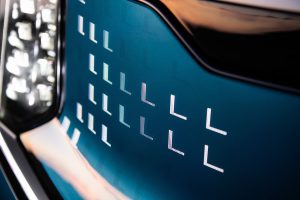
What’s New For 2024
The EV9 is a new model Kia hopes will appeal to people who want a three-row electric crossover SUV but don’t want to pay what Rivian wants for an R1S – which starts at nearly $80,000 – or a Tesla Model X, which also starts around $80,000.
What’s Good
Multiple battery/motor/drive configurations that allow the buyer to prioritize range or power – or something in between.
Rear drive is standard (it’s not available in the Telluride, which is comes standard with front-wheel-drive).
A relative bargain compared with the $80k Rivian R1S and Tesla Model X.
What’s Not So Good
Base price is $20k higher than Telluride’s base price.
Standard range is only about half as far as a fully fueled standard-trim Telluride can go.
Beefy curb weight (5,714 lbs. for the GT-Line) likely means much faster tire wear.
There are a couple of interesting differences between the EV9 and the Telluride – the first being that the latter comes with one engine, regardless of trim (a 3.8 liter V6) while the EV9 is available in multiple configurations.
The second is that the EV9’s standard configuration is rear-wheel-drive, while the Telluride comes standard with front-wheel-drive, which is why it’s more a crossover than an SUV.
The latter being based – typically – on truck-type platforms that are (typically) rear-wheel-drive, with a part-time 4WD system typically offered as an option. The Telluride offers all-wheel-drive as an option, but most of the time, most of the engine’s power is routed to the front wheels.
In the EV9, all the power drives the rear wheels all the time. Unless you opt for the dual motor set up, in which case all four wheels are powered. This set up does not need a 4WD truck-like transfer case and low range gearing to provide even more leverage than the latter because of the high torque of the electric motors and the fact that they drive the wheels directly; the EV9 does not have a transmission in between the engine it hasn’t got and the wheels that turn to make it go.
As far as what makes the EV9 go:
Kia smartly offers potential buyers more – or less – range. As well as more power (at the cost of range) so that buyers can choose the set-up that makes the most sense for the type of driving they do as well as the kind of driving they like to do.
The Light trim touts enough range – 230 miles – for short-distance daily driving in between charging sessions. It does not offer a lot of horsepower – just 215 – but it can still get to 60 in about 7.7 seconds, which is on par with other medium-large crossovers though not nearly as speedy as the much-more-powerful Rivian R1S or the Tesla X.
But it’s also about $30k less than those two.
The Light Long Range lets you push it a little farther (304 miles) at the cost of being a bit slower. This one takes about 8.8 seconds to get to 60. And it’s still about $20k less than either the R1S or the Tesla Model X.
Wind and Land EV9s get a horsepower bump – to 379 horsepower – with in-between Light and Light Long Range range (280 miles).
The top-of-the-line GT Line gets a torque bump (to 516 ft.-lbs.) that is sufficient to move this nearly three-ton SUV to 60 MPH in about 5 seconds- at the cost of 10 miles of advertised fully charged range (which dips to 270).
Driving an EV is like driving any other EV – and that may prove to be the undoing of EVs. Because there isn’t much difference in how they drive. Because the things that used to make for different driving experiences – such as different engines specific to different manufacturers – and transmissions that were geared and programmed differently, from brand to brand – have been replaced (in EVs) with more-or-less the same things.
Every EV has a lithium-ion battery pack that is more-or-less the same as the lithium-ion battery pack in every other EV. Some hold more – or less – charge. But that’s not something you can feel.
It’s the same as far as the electric motors all EVs also all have. There may be just one – or two. And this one may be more powerful than that one. But electric motors are all more-or-less the same in that none of them are much different from one another.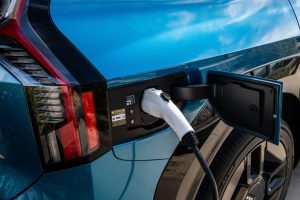
All EVs are silent-drive, because there’s not much to hear. Some produce starship-type noises when you floor what used to be the gas pedal but these are not natural drivetrain sounds.
So, it comes down to such things as how forcefully they accelerate – and how far they go before you have to stop and wait for a charge.
Which brings up some interesting comparisons.
For almost exactly $20k less than the base EV9 Light trim costs, you could drive about twice as far in a Telluride (which stickers for $35,990 to start) that has 376 miles of city driving range and 488 highway miles of driving range, or about 430 miles of driving range, on average.
On the other hand, you could spend about $20k more on a Tesla X or Rivian R1S that goes a lot quicker (0-60 in about 3.8 seconds) but doesn’t go much farther (348 miles) than an EV9 Light long-range.
That’s a difference Kia is hoping to capitalize on.
And there’s one other important difference. The EV9 is the first EV I have ever driven that went farther on a charge than it said it would.
Or at least so it indicated.
After my first drive of about 50 miles, with about 200 miles of indicated driving range remaining at start, about 160 miles of indicated range was still left when I got done. So – according to the Kia’s dashboard computer – I only used up 40 miles’ worth of charge to drive 50 actual miles. If that’s accurate, it’s an accomplishment, because (a) this Kia weighs 5,714 lbs. (for the tested GT-Line with dual motors and AWD) which takes a lot of energy to get moving and (b) because my drive includes a major elevation gain of about 1,500 feet over about three miles “up the mountain” – as well as sustained highway speeds, usually with the AC on.
In other words, real-world driving outside the “city.”
The EV9 is the only EV I have driven so far that didn’t dump about 20 percent more of its indicated range remaining along the course of my drive.
However . . .
When I got in the EV9 to do a “part two” video showing how much range it ostensibly didn’t use, the indicated range remaining display went from 163 to 150 while I was doing the video (and while the EV9 was parked). I also noticed that the range remaining indicator gives you a range in between a high and a low. The low (113 miles remaining) would jibe with my experience of a 20 percent range dump – actual vs. indicated – with other EVs. On the other hand, the high was over 200 miles to go, which seems optimistic from a thermodynamics point of view.
The big question is – how far will it actually go on a charge?
It’s important to know this because of how long it takes to recover charge, which is the biggest practical problem that attends owning an EV. I have a motorcycle that goes about 170 miles before it runs low on fuel. That’s not very far but it doesn’t present an impediment to riding it hundreds of miles farther because I can refuel it in literally two minutes or so. I don’t fear taking it out on the spur of the moment with almost nothing in the tank, either – because I can fill the tank so quickly and easily.
But with an EV, you can only recover a partial charge – at the “fastest” commercial “fast” charger – after about half an hour of waiting. And if you’re not within range of a “fast” charger, your wait at home will be hours longer. Assuming you make it there.
That’s why it’s so important to know how much range you have left – actual vs. indicated.
The EV9 looks a lot like a smoothed Telluride. Same basic profile – and footprint – but sleeker-looking because there’s no grill opening and because the tall (21 inch for the GT-Line) wheels have what look kind of like pizza pie-pan covers, probably to reduce aerodynamic drag.
Like others EVs, the door pulls are flush mounted and electrically extend as you approach the vehicle with the transmitter fob in your pocket.
Also like other EVs, there is a long, rectangular, one-piece flat screen display inside very similar in shape to the LCD panels that began to appear about a decade ago in high-end cars such as Mercedes and BMWs. Back then, these displays were quite a contrast to the old-fashioned-looking (in comparison) analog gauges and buttons and switches most other cars had. But – fast forward to now – and pretty much every car, electric and otherwise, has a touchscreen – as well as ambient interior lighting.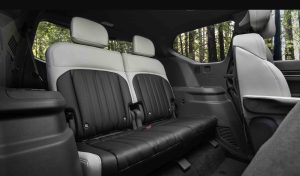
The main thing the EV9 has is a realistically adult-usable third row. It is adult-usable because the EV9 has a flat floor, which is because it’s an EV and there’s no need for the usual hump in the floor to make room for the rear axle and prop shaft that aren’t there in an EV.
The adult-usable third row makes the EV9 usable for 6-7 adults as opposed to 4-5 adults and a couple of young kids. Access to the third row is made easier via electric-forward-sliding second row seats, which also tilt forward.
Unfortunately, the rear-hinged rear doors Kia displayed when the EV9 was a concept car did not make it into production.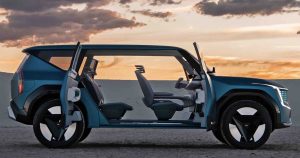
Some EV9-specifics that differ from its IC-engined stablemate include a drive range selector (EVs don’t have gears or shift through them) mounted on a stalk on the right-hand side of the steering column. You rotate this forward to get Drive and back toward you to get Reverse.
To get Park, push the button at the end of the stalk. To turn the EV9 on – or off – push the button at the other end of the stalk.
The Rest
The base Light trim isn’t rated to tow more than 2,000 lbs. but capacity increases to 5,000 lbs. with the more powerful dual motor set-up in the Wind, Light, Land and GT-Line trims. This is the same rated towing capacity as the Telluride comes standard with. But the main thing to keep in mind is that when you’re towing with an EV isn’t that you’ll burn through range faster.
It’s that you’ll need to stop more often to recover charge. 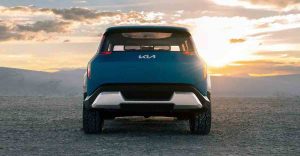
The Bottom Line
A Telluride costs a lot less and goes a lot farther. But the EV9 costs a lot less than a Rivian R1S or Tesla S – and goes about as far.
That might snatch some sales away from Rivian and Tesla.
. . .
If you like what you’ve found here please consider supporting EPautos.
We depend on you to keep the wheels turning!
Our donate button is here.
If you prefer not to use PayPal, our mailing address is:
EPautos
721 Hummingbird Lane SE
Copper Hill, VA 24079
PS: Get an EPautos magnet or sticker or coaster in return for a $20 or more one-time donation or a $10 or more monthly recurring donation. (Please be sure to tell us you want a magnet or sticker or coaster – and also, provide an address, so we know where to mail the thing!)
If you like items like the Baaaaaa! baseball cap pictured below, you can find that and more at the EPautos store!



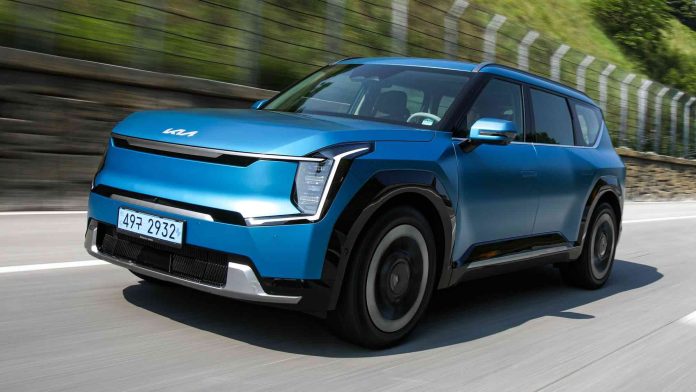



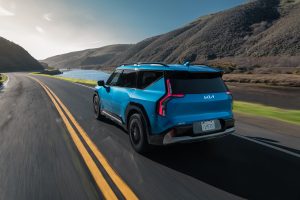








There will always be those among us with more money than brains, or who buy things to impress people they don’t like. That’s where EVs fall in the general scheme of things. Impractical in most use cases, and clearly inferior to what is being replaced. Never underestimate the ability of semi-wealthy people to operate against their own financial interest.
I used to believe that EVs would appeal to those who have never driven a car before because they have never had the experience of filling the tank of a conventional ICE vehicle in five minutes verses 30 minutes with an EV at a “fast” charging station. Yet, even a majority of those Gen Z youngsters have little or no intention of buying an EV according to multiple polling reports.
So, where does this all lead? The EV market is saturated, new buyers are extremely skeptical and unwilling to pay more for a car that doesn’t fit their driving needs, and automakers are finally pulling back on their “ambitious” (unrealistic) EV goals just to keep from going bankrupt.
I predict the entire EV push will go down in history as one of the most disastrous business failures in the U.S., one that will be memory holed by the automotive and business media that acted as cheerleaders for a team being shut out in the final seconds of a game.
Hi KTL,
In re: “I predict the entire EV push will go down in history as one of the most disastrous business failures in the U.S., one that will be memory holed by the automotive and business media that acted as cheerleaders for a team being shut out in the final seconds of a game.”
I hope so. But this is more (in my opinion) than just another corporate-lemming belly flop. This is the apotheosis of the war on the privately owned car – at least insofar as the average working/middle class person is concerned.
Thanks for your reply Eric. Full agreement here regarding the war on cars, which has been underway since at least the 70’s. People who are free to move about on their own are much harder to control than those with little or no mobility options.
The intentions of our so-called leaders are becoming much more obvious with each passing day.
This Taycan EV owner charged his EV at a public charger in Britain…it cost him about 47 pounds…$59.00 to get about 63 KWH of charge….about 75 pence….93 cents per KWH……..it gives him about 170 miles range in warm weather…maybe half that in very cold weather….
93 cents per KWH……today…in 2030 will it be $4.00 per KWH?….lol
$59 to go 170 miles…
a good 50 mpg diesel ice car…to go 170 miles would only need about 3.5 gallons of diesel at about $6.00 per gallon….about $21.00….
https://www.youtube.com/watch?v=zfk-N4vSimw
When will this idiocy end?
https://www.youtube.com/watch?v=dH-tt0wSuL0
I would rather drive Ford model A. Might be slow but can be refueled in minutes.
‘big question is – how far will it actually go on a charge?’ — eric
What’s actually being measured (somewhat imprecisely) is the battery’s state of charge. Then an algorithm applies correction factors and displays a remaining range value.
From your description of sudden drops and jumps in this and other vehicles, the ‘remaining range’ algo isn’t very bright. Some apply smoothing functions; others don’t. It’s a low-IQ chip; don’t expect it to quote Shakespeare.
Compared to gallons of fuel remaining, which can be measured exactly, remaining range is a nebulous and variable figure. Indeed, crank that 708-watt stereo to 11, and you might lose ten miles of range just from the thumping bass:
Say it again, y’all
e-car, huh (good God)
What is it good for?
Absolutely nothin’, listen to me, oh
— Edwin Starr, War
https://www.youtube.com/watch?v=MbejY1FdVyw
2024 Kia EV9 driver…competing, controlling, surveillance and ratting out features….
Highway Driving Assist (HDA 2)
Vehicle Stability Management (VSM) Electronic Stability Control (ESC)
ABS And Driveline Traction Control
Side Impact Beams
Dual Stage Driver And Passenger Seat-Mounted Side Airbags
911 Connect Emergency Sos
Parking Distance Warning Front And Rear Parking Sensors
Blind Spot
Forward Collision Mitigation w/Left Turn Assist
Lane Keeping Assist System (lkas) w/Lane Following Assist (lfa) Lane Keeping Assist
Lane Keeping Assist System (lkas) w/Lane Following Assist (lfa) Lane Departure Warning
Collision Mitigation-Front
Driver Monitoring-Alert
Collision Mitigation-Rear
Tire Specific Low Tire Pressure Warning
Dual Stage Driver And Passenger Front Airbags
Curtain 1st, 2nd And 3rd Row Airbags
Airbag Occupancy Sensor
Driver Knee Airbag
Power Rear Child Safety Locks
Outboard Front Lap And Shoulder Safety Belts -inc: Rear Center 3 Point, Height Adjusters and Pretensioners
Back-Up Camera
Is Kia losing money on these?
Hi Dan,
I can’t say for sure, but I’d assume so. Because no one – not even Tesla – is making any money selling EVs.
5,700 pounds! What a joke! That’s 1,000 pounds heavier than a 1985 Suburban!!
I wonder how much driveway and garage concrete damage someone is willing to put up with with these things?
Hi Philo,
Yup. And you ought to see the tires on this thing. My bet is they cost $300 each.
So my 3 ton floor jack has barley enough ooomph to lift that beast? No thanks.
Barely not barely. Autocorrect is gonna drive me to the barley corn whiskey.
As I read this I wondered how much further it would go if it went on a diet? Imagine the same battery pack and drive train in a long and low sedan. But really how much weight do plastic seats and paper thin lift gates add? Maybe get rid of some airbags, but you’ll still need to keep the heavy passenger cage and of course the massive wheels.